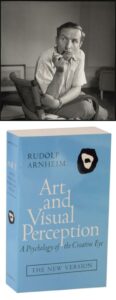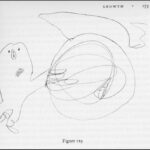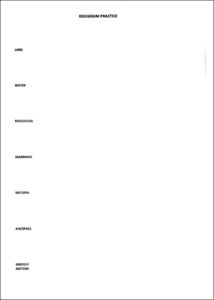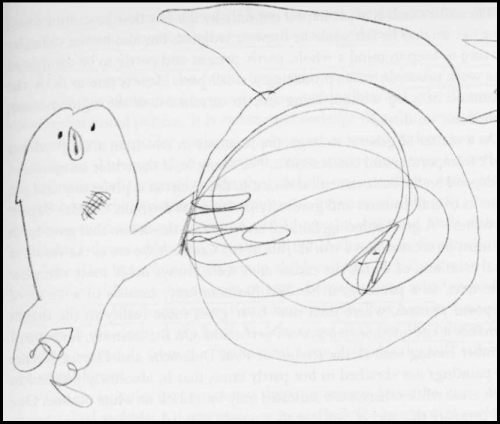(NOTE: The topic of ideograms is of most importance to those learning or practicing controlled remote viewing. But they are something that anyone interested in remote viewing should know at least a little about. Recently, ideograms have become a matter of controversy in Facebook remote viewing groups. In the process of going through some files, I came across a version of the following article, which I originally wrote back in 2001 for my students, as well as others who might need a tutorial on the subject. I have now updated it for current purposes. It should be helpful in navigating that controversy.)

In the years while remote viewing was being explored at SRI-International, researchers Hal Puthoff and Russell Targ developed a clever way of dealing with reporters, scientists, and government officials showing up at SRI demanding proof that remote viewing really worked. Instead of trotting out some stellar remote viewing performer whose success would be doubted even if demonstrated under the very nose of the questioner, visitors were challenged to try it themselves. Many of them accepted the challenge, and most of those were successful. All these sessions done by people “right off the street,” amounted to more than 140 remote viewing trials that were useful as scientific data.

In looking over this pile of RV transcripts, Ingo Swann—the originator of remote viewing and one of the lead experimenters for SRI—noticed something peculiar. Both experienced and inexperienced viewers were encouraged to remote view with pen and paper in hand, to record their impressions in word and sketch during the session. But nearly every time someone launched into remote viewing, he or she seemed to have the urge to make a little scribble on the paper when first contacting the signal line.
Ingo found something familiar about the behavior, and the scribbled results it left. One day it suddenly dawned on him—it reminded him of a chapter in Rudolf Arnheim’s book, Art and Visual Perception, which Ingo had first read when studying art in college. Arnheim had looked at the way in which young children first approached art, and what role their newly developing perceptual abilities played. When first learning to capture on paper the things around them, young kids made scribbles that were very similar to those of remote viewers. It was as if the children were intuitively trying to grasp the essence of the subject they wanted to draw. Essence is closely akin to—perhaps identical with—the notion of gestalt.1 Ingo wondered if perhaps these little scribbles were the initial prehension2 of the major gestalt (or gestalts) of the target.

After experimenting with the concept, Puthoff and Swann decided that indeed the scribble was a primitive representation of the target’s gestalt. Seeking for a word to call it, they happened upon “ideogram,” which means basically a graphic mark that represents a thing in itself, and not the word for that thing. Even outside of the field of remote viewing, ideograms are generally “depictive,” or pictorial in nature. Swann and Puthoff noticed that these ideograms had an involuntary, reflexive quality about them. Given a viewer, a pen, and a piece of paper, an ideogram occurred almost spontaneously as soon as the viewer was read the coordinate or tasking number and touched pen to paper.3
Experience showed that these reflexive marks often resembled a part or the whole of the of the intended target. And no two ideograms were exactly alike. They varied in form and pattern just as the remote viewing targets that generated them did. To be sure, there might be similarities between ideograms, just as there are similarities between targets. For example, the Cheops Pyramid in Egypt and the pyramid-shaped Luxor Hotel in Las Vegas might present similar-appearing ideograms. But an ideogram representing Cheops would likely be noticeably different from one for the Empire State Building.

Later, when he began to teach the skill, if Swann ever noticed that students were “in a rut” and starting to make ideograms that looked too much like each other, he made them do one or two ideogram “drills,” a conscious exercise designed to loosen up the production of unconscious ideograms, in hopes of getting the students to relax and allow them to form in a less rigid and stylized way.
.

Ideograms have some interesting qualities about them. They have a motion and a feeling. “Motion” means the sense of motion the viewer experiences as she or he executes the reflexive mark on the paper. This is a rather subtle point to grasp, since it is not the motion of the pen itself that is meant, but rather a nuanced sense of contour, motion, and direction that comes to the viewer kinesthetically4 while creating the ideogram on the page. The motion itself is in some way not immediate—meant in the sense of being physically present. But it nevertheless is perceivable by the viewer, once he or she learns to be responsive to it.
The “feeling” has some of these same qualities—specifically, that the viewer experiences this feeling kinesthetically and intuitively. “Feeling” refers to the consistency of the gestalt. In this case we’re not talking about surface properties such as temperature or texture. In other words, not whether something is rough or smooth, warm or cold, but instead whether it is hard or soft, fluid, airy or gassy, squishy, and so forth. A structure or land-form is usually “hard” or “solid.” Water (or gasoline or even liquid nitrogen) is experienced as ” liquid,” or “fluid.” This is meant in the adjectival, descriptive sense (For example: “This substance is ‘liquid,’ or ‘fluid'”) and not as a noun (“This substance is a ‘liquid,'” or “Oil is a ‘fluid'”). Sand dunes might produce a feeling of “semi-soft,” while a swamp might be “semi-hard,” or even “squishy.” Interestingly, some gestalts that might otherwise be described as “solid,” came across as “airy” instead. For instance, long suspension bridges that encompass a large area, most of which is airspace outlined and defined by metallic components, often produce “airy” feelings. The “motion” and “feeling” compose what Ingo Swann called the ‘A’ component. (There is more to what is called Stage 1 in controlled remote viewing, but this is enough for our purposes here.)
In recent years, some remote viewing practitioners have tried to control ideograms by telling fledgling viewers that they should establish ideogram “lexicons,” where each ideogram becomes a fixed symbol of a specific gestalt. Under this system, if the target is a structure or building, the viewer might be taught to always produce a certain right-angled mark out of his or her subconscious that tells the viewer the target is a structure. Water might always present in only one way (perhaps a wavy line), as would land (maybe as an even line that slightly curves over). Other types of gestalts would similarly produce some fixed ideogram-shape.

This idea of a “lexicon” is foreign to what Swann taught us about ideograms. Creating a fixed way of representing an ideogram is like putting it in a strait jacket. It destroys its creative content. True ideograms are literal representations of the actual target, from which the viewer identifies the gestalt. This means that each target will produce a unique ideogram, which may even vary for the same viewer should he or she later revisit that same target. This explains the diversity in appearance of ideograms if they are left to form as they will. Purposely restricting to only a narrow range the forms ideograms can take, and assigning set meanings to them, turns them into nothing more than a self-limiting alphabet with impoverished content.
“Installing” and automatizing this limited ideogram vocabulary into the student’s subconscious requires innumerable tedious and laborious ideogram “drills.” Serving a noticeably different purpose than the drills Swann only on rare occasions put his students through, this new version of ideogram drills involve the student listening to long, tedious repetitions of the various possible gestalts (the basic number is claimed to be seven) while jotting down the relevant squiggle the student has chosen to represent each particular gestalt.

There is a certain attractiveness to this practice. It allows a sort of “shorthand” for ideograms which avoids the early uncertainties of students just learning how to identify the subtleties of the kinesthetic, intuitional process. In a way, those who insist on the “lexicon” approach are generally impatient to get immediate analytical answers and avoid the chore of properly working through the classic start of a controlled remote viewing (CRV) session. They are looking for a shortcut that allows them to identify the gestalt without having to go to the trouble of schooling their intuition in how to distinguish the natures and qualities of various real-world gestalts.
It might seem at first that it would be nice to be able to have unambiguous, immediate knowledge of the target—the sort of knowledge one gets when one can look with one’s physical eyes upon it. But the full remote viewing process does not work like vision or the other physical senses. By trying to take such shortcuts, one does not enhance, but rather ultimately inhibits the remote viewing experience. In so doing, one allows the left-brain, analytical mind to remain engaged longer than it ought to be—essentially putting off “being psychic” past the beginning and into the main body of the session. This seems to be defeating the purpose.
Like any other skill involving the need to recognize, distinguish, and identify subtle input (the notoriously tricky skill of sexing chickens comes to mind), the only way to actually make it easier and more reliable is to consistently apply the correct skills–in other words, frequent practice, using correct principles.
———
- Gestalt: An organized whole that is more than the sum of its parts. One can think of a gestalt as a non-physical concept that depends entirely for its existence on it component parts, plus their relationship to one another. For example, in the physical world, rocks, snow, water, trees, cliffs, peaks, and so on are the parts that combine to make up a mountain. “Mountain” is the major gestalt (things just mentioned such as a rock, tree or cliff can each be their own “minor” gestalt, made up of its own smaller component parts). If these parts are not in the proper relationship to one another, the concept of mountain doesn’t exist. Concrete nouns are always used to refer to gestalts—e.g., “mountain,” “building,” “ocean,” and so on.
- Prehension: The relation between a perceiver and something being perceived where perception occurs but not necessarily cognition.
- Coordinate or tasking number: A number that substitutes for verbal directions to start a session. Instead of telling the viewer to “Remote view the Eiffel Tower,” the number 8675309 might be substituted by the tasker or project manager as the “get ready, get set, go!” signal for the session. Since proper remote viewing requires the viewer not be told what the target is until after the session is completed, this allows the viewer to be launched without violating that principle.
- Kinesthetic: A Sensory/perceptual experience derived from muscle and bodily movement, sometimes very subtle and unconscious. Kinesthetic prehension generally occurs prior to or even in the absence of subsequent cognitive awareness of what is sensed. In remote viewing, kinesthetic perception may occur when the remote viewing signal-line impacts the viewer’s underlying perceptual processing centers and is then manifest by bodily movements, such the arm and hand movements creating the ideogram.
